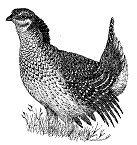Papers in the Biological Sciences

Papers in Ornithology
Document Type
Article
Date of this Version
2012
Citation
Published in PLoS One (2012) 7(11): 1-8. DOI: 10.1371/journal.pone.0048842
Abstract
Background: Old World vultures are likely polyphyletic, representing two subfamilies, the Aegypiinae and Gypaetinae, and some genera of the latter may be of independent origin. Evidence concerning the origin, as well as the timing of the divergence of each subfamily and even genera of the Gypaetinae has been elusive.
Methodology/Principal Findings: Compared with the Old World, the New World has an unexpectedly diverse and rich fossil component of Old World vultures. Here we describe a new accipitriform bird, Anchigyps voorhiesi gen. et sp. nov., from the Ash Hollow Formation (Upper Clarendonian, Late Miocene) of Nebraska. It represents a form close in morphology to the Old World vultures. Characteristics of its wing bones suggest it was less specialized for soaring than modern vultures. It was likely an opportunistic predator or scavenger having a grasping foot and a mandible morphologically similar to modern carrion-feeding birds.
Conclusions/Significance: The new fossil reported here is intermediate in morphology between the bulk of accipitrids and the Old World gypaetine vultures, representing a basal lineage of Accipitridae trending towards the vulturine habit, and of its Late Miocene age suggests the divergence of true gypaetine vultures, may have occurred during or slightly before the Miocene.


Comments
Copyright © 2012 Zhang et al. This is an open-access article distributed under the terms of the Creative Commons Attribution License, which permits unrestricted use, distribution, and reproduction in any medium, provided the original author and source are credited.